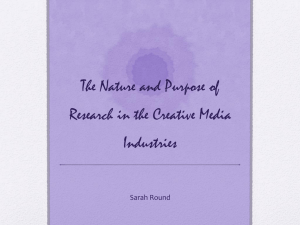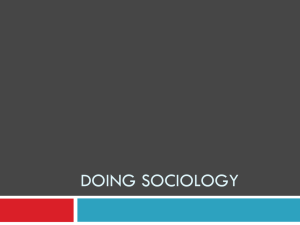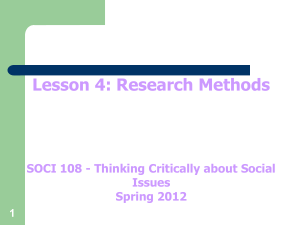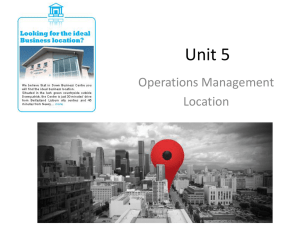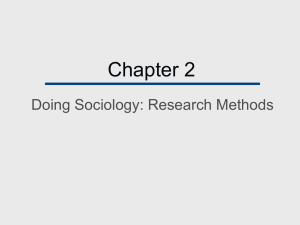Doing Sociological Research
advertisement
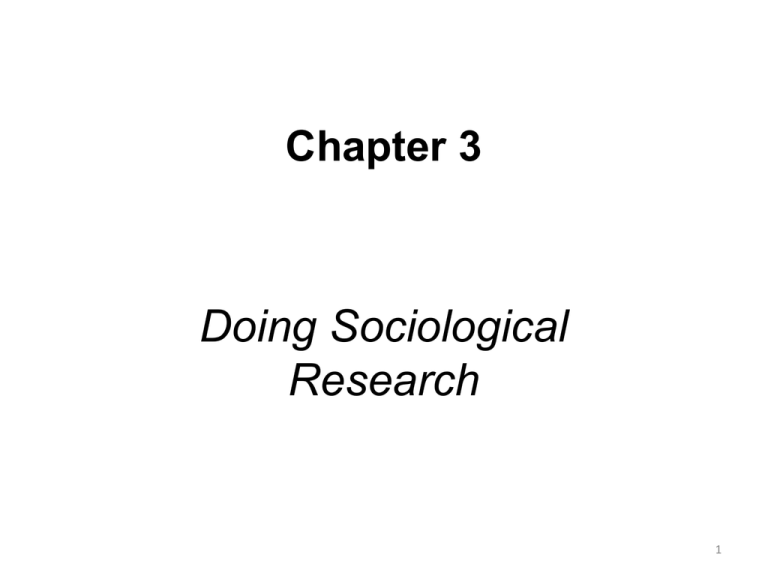
Chapter 3 Doing Sociological Research 1 Sociology & the Scientific Method The research process: 1. Developing a research question 2. Creating a research design 3. Gathering data 4. Analyzing the data 5. Reaching conclusions and reporting results 2 The Research Process Step I: Develop a Research Question • Researchers design studies to test the influence of one variable on another. • A variable is a characteristic that can have more than one value or score. • ex. How does age effect income? – Independent Variable is the presumed cause of the outcome (age). – Dependent Variable is the variable that is the presumed effect (income). 3 The Research Process Step II: Research Design – Quantitative studies are usually statistically sophisticated. – Qualitative studies are more interpretative observations. 4 The Research Process Step III: Gathering Data • Primary data is original data gathered specifically for this project. • Secondary data is data gathered from an earlier study or purpose. 5 The Research Process Step IV: Data Analysis - Organize collected data to discover the patterns and uniformities that the data reveal. - Quantitative vs. Qualitative data 6 The Research Process Step V: Conclusions -Generalization is the ability to draw conclusions from specific data and to apply them to a broader population 7 The Tools of Sociological Research 1. 2. 3. 4. 5. 6. survey research participant observation controlled experiments content analysis historical research evaluation research 8 1. Surveys Advantages Disadvantages • Surveys make it possible to ask specific questions about a large number of topics and then to perform sophisticated analyses to find patterns and relationships among variables. • The structured or rigid nature of the questions often makes it difficult to accurately capture the opinions of the respondent or fail to capture nuances in people’s behavior and attitudes. 9 2. Participant Observation Advantages Disadvantages • The observer gets to know the study group very well and gets vast subjective information about the group members. • These studies have added to the rich body of sociological research. • There may be too much information to analyze systematically. • This data collection technique and its analysis is very time consuming. • Interpretation may not be objective. 10 3. Controlled Experiments • Controlled experiments are highly focused ways of collecting data and are especially useful for determining a pattern of cause and effect. – This research requires creating two different groups: • an experimental group, which is exposed to the factor or variable one is examining, and • a control group, which is not exposed to the factor or variable being tested. 11 Controlled Experiments Advantages Disadvantages • A controlled experiment can establish cause. • It is an artificial environment. • Large-scale community based studies do not lend themselves to experimental research designs. • Required ethics must be adhered to, which are difficult to follow. 12 4. Content Analysis – In content analysis the researcher analyzes cultural artifacts such as newspapers, magazines, TV programs, fairy tales, comic books, or popular music. 13 Content Analysis Advantages Disadvantages • The research has no effect on the person being studied, because the cultural artifact has already been produced. • Content analysis is limited in what it can study. • These artifacts are not developed for research purposes. Therefore, it cannot tell us what people really think about these images or whether they affect people’s behavior. 14 5. Historical Analysis Advantages Disadvantages • Long term social changes are easy to capture. • This is a perfect sociological tool for conducting studies of history or comparative perspectives. • Knowing whether the reports are allegories or factual details is subject to interpretation. • Interpretation errors are easy to make when the information is symbolic or in an unfamiliar language. 15 6. Evaluation Research • Evaluation research assesses the effect of policies and programs on people in society. – Policy research is the term used when the research is intended to produce policy recommendations. • Social organizations and governmental agencies use policy research in order to make recommendations to Congress on such issues as: – Improving school performance – Health care funding and service needs 16 Research Ethics • Question: Can a researcher be value-free? 17 Summary of Research Methods • • • • • • Survey Participant Observation Content Analysis Controlled Experiment Historical Analysis Evaluation Research Academic performance & Gender Hypotheses • Working hours/ studying hours (S) • Note taking technique (C ) • Drinking (CE / S) • Students’/teachers’ attitudes & attention during the class (P) • Freshmen vs. senior (H) • “Gender Separated Class” Program (E ) 19 20 Quiz Question • Which is the best source of information to use to conduct a study comparing the percentage of Hispanics in the U.S in 1980 to those in 2006? a. an interview of youth in probation center b. a national survey of the youth population in the United States c. a combination of a questionnaire and an interview d. secondary U.S census data 21 1. Explain the difference between qualitative and quantitative data collection methods. 2. Give examples of each and develop a research question that is best tested with: – qualitative empirical techniques – quantitative research method 22 Discussion Questions 1. Develop a hypothesis to study a social issue such as: drug use, drug addiction, student study habits, smoking, sexual behavior, or another subject of your choice. 2. State the hypothesis in an as if format as discussed in the research design paragraph of your text. 3. Will you use qualitative or quantitative analytic methods, or a combination of both to test this assumption? – Explain the rationale behind your decision. 23



